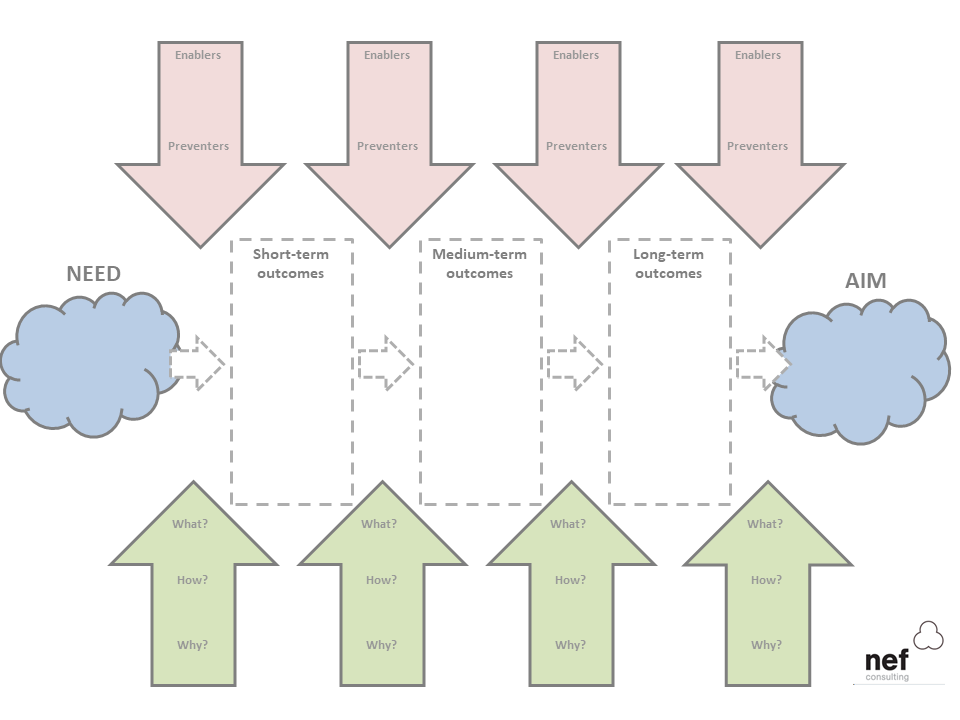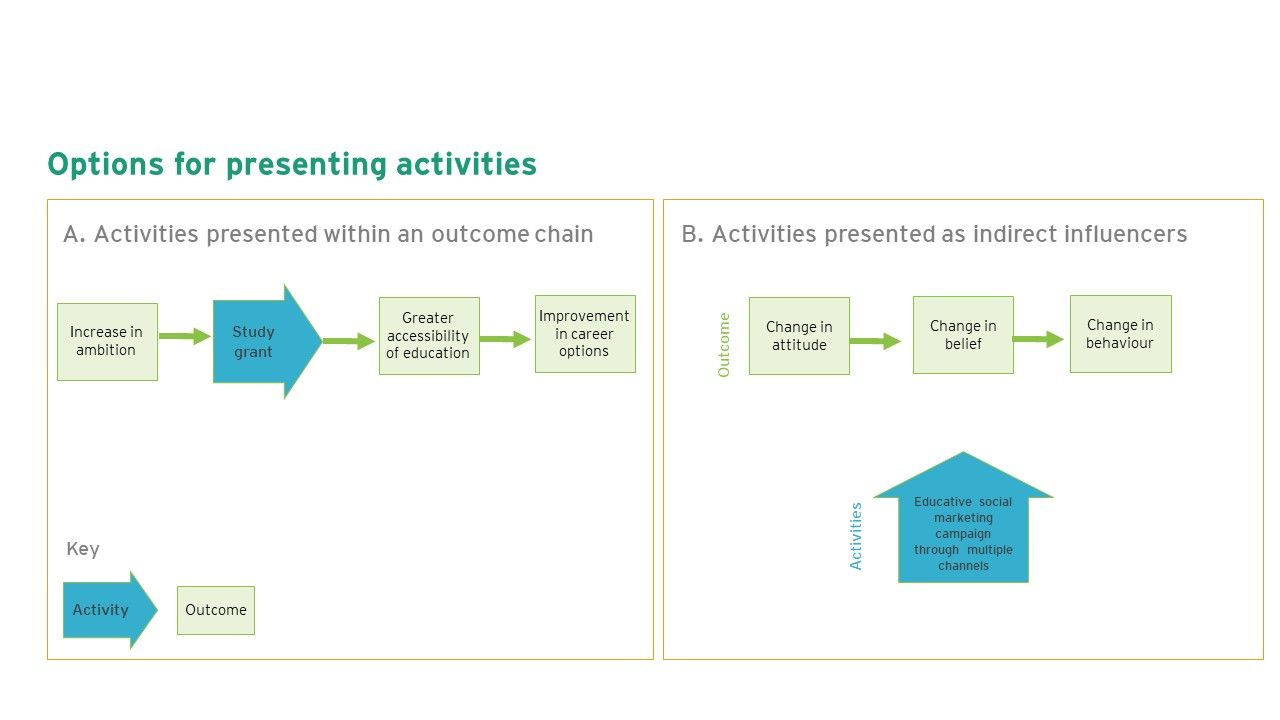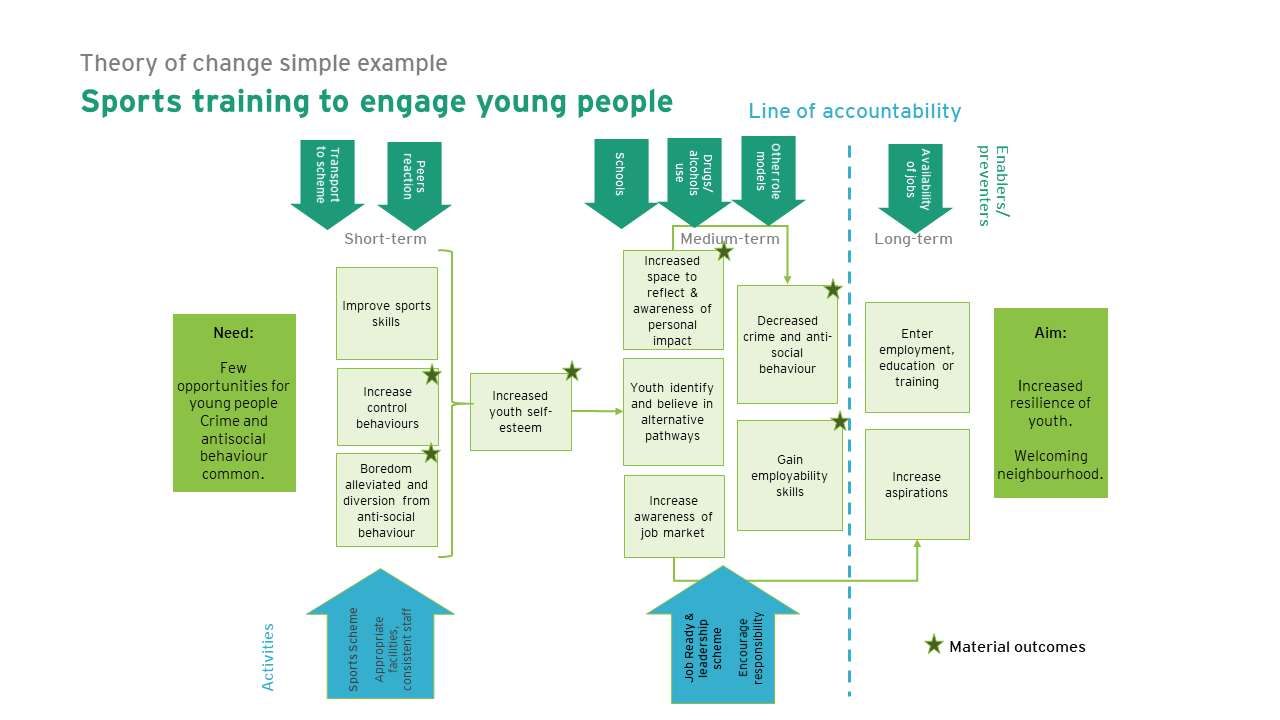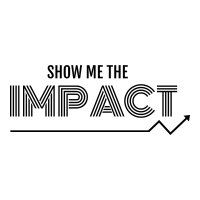How to create a Theory of Change: a seven step method
Creating a Theory of Change can feel formidable. Here I share a simple framework method that helps organisations pull together a draft in as little as 30mins.
The key to progressing a Theory of Change is to get a minimal viable product down on the page. You should then return to the details and finesse with your stakeholders through interviews and workshops. You do not need to have all the answers first time around. We work in complex, changing social systems, so iteration will be your friend.
The framework
At NEF Consulting, a talented colleague of mine, Jenny Rouse, drew up a simple template for building your Theory of Change. It helps organisations capture all the component parts of a Theory of Change in one place. Start with this template. Ultimately you will want to find your own way of presenting the diagram, so that it has your organisation’s personality.

Steps
1. Set scope
A Theory of Change is contained within what I call the bookends of the diagram: the aim and the need.
The aim is the picture-perfect description of what you would like to achieve. It is a vision realised for your stakeholders. I often like to call it the guiding star for your work. In that sense it doesn’t have to be something achievable, but something that shows your direction of travel. So big esoteric statements like “happy, healthy people in a resilient neighbourhood” or “a thriving science and technology sector” can work. Try to make it relevant to your stakeholders and avoid recycling mission statement as this often includes activities or the way an organisation works.
The need on the other hand, defines the problem you are addressing, or the cause for your work. You can choose the level of complexity you provide here. You could focus on something like “supported living residents are experiencing loneliness” or you could chart key systemic causes for social isolation in society. A clear and insightful understanding of the drivers and context for your work will enable better intervention design. As Einstein once said:
Given one hour to save the planet, I would spend 59 minutes understanding the problem and one minute resolving it.
Finally, you will notice the diagram is split into phases: short, medium and long-term. This linear layout works really well for project and program level Theories of Change. You might find organisational and systemic ones look more cyclic. What is critical is that you layout a flow, or causal chain of outcomes leading from your need towards your aim.
So as part of step one, set out:
A. Your overall aim* - identify a goal statement: the end point of the Theory of Change.
B. The need for your work – what problem is the programme aiming to address?
C. Periods – what will short, medium and long-term refer to in the journey towards your aim? Could it be pre-intervention, during intervention and post-intervention?
*I am often asked whether you should start with the aim or the need when plotting a Theory of Change. The answer is either! Most social change activists have a better understanding of what they are trying to achieve (what they are for rather than against). However, it is possible to use Theory of Change as an innovation and planning tool. In that case, you might start with a really good understanding of the problem you are addressing, and then design an intervention (activities) and associated outcomes by plotting forwards on the diagram.
2. Identify material (most important) stakeholders
For your primary stakeholder(s) you are going to develop a journey of change across the short, medium and long-term periods.
D. Select a primary stakeholder for your intervention and maybe critical secondary stakeholders.
Identifying your stakeholders sounds simple, but the broader the initiative (think organisation scale) the more difficult this exercise will be. In fact, I often find this to be the most challenging step in developing a Theory of Change or impact management system.
Stakeholders are material, if you create significant change for them through your work. Your stakeholders are not supporting actors or partners. The change should also be relevant to your overall aim. As a useful rule of thumb, I suggest picking somewhere between one and five stakeholders to focus on. The more you add, the more unwieldly your Theory of Change will become.
3. Map outcomes
The next step is to populate a causal flow of outcomes from the need to the aim. I suggest doing this initially on post-its (sticky notes) with one outcome per post-it. You will inevitably want to move the outcome sequence around as you begin to chart a timeline.
Critically, make sure you are describing outcomes not outputs. So, we are looking for “increase in skills” rather than “achieve a certificate”. The certificate is an output of the learning, but your stakeholder may have already had sufficient skills to obtain a certificate regardless of your activity. So it does not necessarily mean the outcome has taken place.
There is no single, hard and fast way of mapping the outcome chain, but why not:
E. Plot outcomes by working backwards from the goal to the intermediate outcomes, and finally to the short-term outcomes. You should be asking “what change has to happen in order for this to be achieved?”. This ensures that the focus is on what has to be done to achieve the goal and intended outcomes, rather than on what the current activities are.
If you have multiple stakeholders, I recommend initially plotting causal chains in rows for each stakeholder separately and with a different colour post-it. You can later intermix the connections to better tell the story.
Once you have all the outcomes mapped, ask yourself whether you have also been honest about any negative outcomes. Mapping, and potentially measuring, negative side effects will help to minimise their effects.
4. Add activities and explore assumptions
Activities are what you do as part of your intervention to create the outcomes. They should be included in your diagram to show how you are driving the outcomes chain.
How you present your outcomes will depend on the nature of your intervention and your personal preference. Sometimes activities directly drive outcomes, for example, providing a study grant or scholarship may increase the accessibility of education. In this case, you may wish to present the activities as a stepping stone within the outcomes chain (shown in box A in the diagram below).

Other times, your activities may have a more complex indirect relationship with outcomes. An example might be campaigning leading to changes in public opinion. In these cases, you may prefer to group them – perhaps under the respective short- or medium-term outcomes that they are driving. Either way:
F. Add activities – one per post-it, ideally on a new colour. Then arrange them as closely to the activities they drive as possible. Add arrows where there is a clear direct relationship between activities and outcomes and also between sequential outcomes.
Once you have the activities noted, it is critical to explore the logical links between activities and the outcome chains you have created. Document how and why you deliver your activities in the way you do. So use these as prompt to:
G. Document assumptions -
# How are you going to deliver the activities? What characteristics in the way you work are important?
# Why are these activities important and causally related to the outcomes?
# Why do the outcomes captured sequentially build upon each other?

5. Advanced step (i): adding context
No intervention exists in a vacuum. There will always be factors which either hinder or help you move stakeholders across your Theory of Change and towards your ultimate aim. Adding a list of enablers and preventers will build another layer of sophistication into your thinking. It will highlight preventers which need to be managed, for example poor transport links or unexpected pandemics, and enablers that need to be maximised, for example other actors working for your cause.
Enablers and preventers can be at any scale from individuals, like family members, to systemic considerations, like a depressed job market. Add what you feel is most relevant to your context. It is worth noting that single factors are often both enablers and preventers.
H. Add enablers - what are the conditions or actors, that will help the positive changes you have identified be achieved?
I. Add preventers – what are the barriers, which might prevent your intended outcomes from being realised?
6. Advanced step (ii): material outcomes and line of accountability
If you plan to use your Theory of Change as a tool for evaluating your impact, or collecting impact data, you will need to decide which outcomes your success should be judged against.
There are two final features of the Theory of Change diagram that will help you set the boundaries for your responsibility. Firstly, there is the line of accountability; the point up to which it is reasonable, and plausible for you to have had significant control over the outcomes being realised.
This line often lies between the medium and long-term outcomes on diagrams. However, it can sometimes be wiggly, or come earlier or later depending on how much is appropriate. Hearing about a line of accountability is normally a big relief for those putting a Theory of Change together. The whole Theory of Change diagram paints the big picture. The line of accountability shows your role within that story.
J. Draw a line of accountability around the outcomes which you believe are reasonably within your sphere of influence.
Once you have a line of accountability you will want to select the material outcomes on your diagram for measurement. Material outcomes are those which are:
· Relevant to the aims of your project
· Significant in size due to your actions
You will be selecting outcomes prior to your line of accountability if it is linear. If you have a chain of causally related outcomes, it makes sense to pick the final outcome in a chain to minimise double counting. For example, a workplace campaign might have an outcome chain including: greater pride in the organisation > greater interest in work > greater employee engagement. In this case, you may select only “greater employee engagement” as material.
K. Mark material outcomes – select the most relevant and significant outcomes before the line of accountability for taking forward for measurement.
7. Finally review and iterate
By this point you will have a first draft. Does this capture a full picture of the change you are supporting? Are the outcomes articulated in the right way? Are the assumptions underpinning the model plausible?
Once you are happy with your first draft it is time to take it out to your stakeholders. Interview or workshop with your beneficiaries, partners and anyone else who is affected by your work to test whether you have put together a plausible and accurate model. Listen to the language your stakeholders are using, and try to reflect this in your model.
Once you are happy with the detail, find a diagram shape or infographic layout that elegantly captures your Theory of Change. You do not need to include everything in one diagram. We are aiming for accessibility: a diagram that needs the least possible explanation. That said, do combine your diagram with a narrative(s). The nature of this narrative will depend on whether it is for a report or pithy copy for a website "about us" page.
Most of all, have fun! Welcome the complexity and meaningful conversations. I love Theory of Change because it sharpens organisation's thinking and helps them to think systemically.
